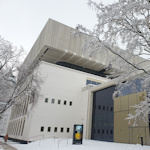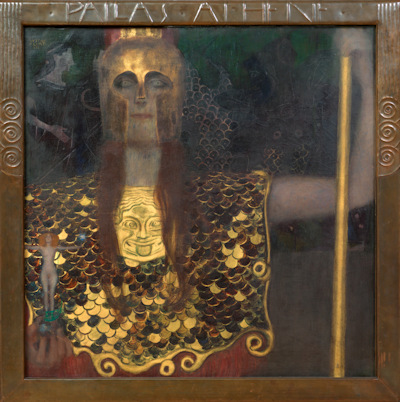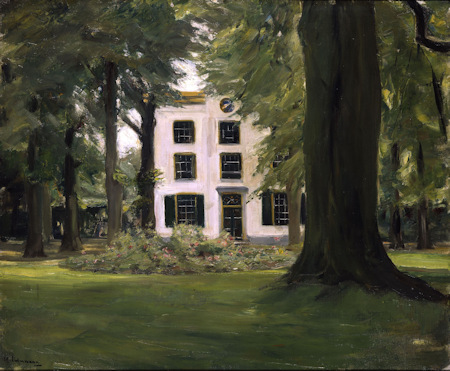
Cultural history, Vienna around 1900, and a notable number of masterpieces: the Secessions exhibition at the Wien Museum delivers a triumvirate of pleasure.
- Covers the secessionist movements in Munich, Berlin and Vienna
- Numerous important art works and names feature
- …including, of course, Gustav Klimt
- Runs May 23 – Oct 13, 2024
- See also:
- Other art exhibitions in Vienna
Klimt, Stuck, Liebermann

(Gustav Klimt: Pallas Athene, 1898, 75 x 75 cm, Wien Museum; press photo: Birgit and Peter Kainz, Wien Museum)
The time around 1900 in Vienna seems to have acquired an almost mystical aura to it. You begin to imagine the city was 90% inspired creatives and intellectuals, 7% coffee house waiters and 3% artist’s models.
Reality was very different, of course (ask the people working on the Ringstrasse construction sites). But it was indeed a time of transition toward modernity in a melting pot of a city.
The art world, for example, began to throw off the shackles of traditional structures and abandon rigorous definitions of what was right and wrong, chipping away at the existing barriers between approval and rejection.
In Vienna, you had Klimt and colleagues leaving the Künstlerhaus artist association to establish the Secession in 1897: an association built around greater creative freedom, openness to external and international influences, and more autonomy for the individual artist.
The results led to a thunderstorm of creativity and a diversity of artistic expression.
But Vienna did not have the monopoly on secessionist movements.

(Max Liebermann: Country House in Hilversum, 1901, oil on canvas, 65 x 80 cm; press photo © Staatliche Museen zu Berlin, Nationalgalerie / Jörg P. Anders)
The Munich Secession, for example, appeared in 1892…five years before the Viennese equivalent. Berlin followed in 1898. All driven to move away from the corset of controlled conservatism.
All three groups had their figureheads: the names always mentioned in association with the relevant secession. So while the Vienna Secession counted the likes of Koloman Moser and Josef Hoffmann among their founders, people always think of Gustav Klimt in this context.
In Munich, it was Franz von Stuck. In Berlin, Max Liebermann.
These three secessions form the topic of the same-named exhibition at the Wien Museum, created in cooperation with Berlin’s Alte Nationalgalerie.
Secessions explores the movements, their impacts and commonalities. All with the help of numerous illustrative works of art.
Which means we get to see a fair few masterpieces. And not just from the three named protagonists.
Expect to also view art by the likes of Lovis Corinth, Edvard Munch, Max Klinger, Käthe Kollwitz, Auguste Rodin, Max Kurzweil, Carl Moll, Ferdinand Hodler, Koloman Moser, Otto Wagner, and many more.
I’ll add further details once I’ve had the chance to see the exhibition in its final form.
Dates, tickets & tips
Enjoy Secessions from May 23rd to October 13th, 2024. Entry to the permanent exhibition of the Wien Museum is free but special exhibitions require a €12 ticket.
The Secession continues in Vienna today, and their famous home is just a short walk from the Wien Museum. Inside you find contemporary art exhibitions and Klimt’s monumental Beethovenfries.
For more secessionist art, your best bets are the permanent exhibitions at Upper Belvedere and the Leopold Museum. Both have extensive collections from that period, including many paintings by Klimt.
How to get to Secessions
Follow the travel tips on the Wien Museum Karlsplatz page.
Address: Karlsplatz 8, 1040 Vienna